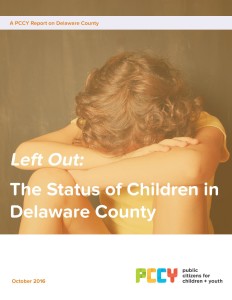Children Still in Recession in Delaware County Despite Recovery
Trẻ em nghèo gia tăng và thành tích học sinh thấp hơn phủ bóng đen lên mức tăng khiêm tốn
 Philadelphia (Oct 13, 2016) – While recent headlines tout a national recovery from the Great Recession, more children in Delaware County are facing hardships than during the depths of the recession, a new study has found.
Philadelphia (Oct 13, 2016) – While recent headlines tout a national recovery from the Great Recession, more children in Delaware County are facing hardships than during the depths of the recession, a new study has found.
Công dân cộng đồng dành cho trẻ em và thanh thiếu niên [PCCY] thông báo mới báo cáo toàn diện on the status of children in Delaware, Montgomery, Bucks and Chester counties, entitled, “Left Out.” The Delaware County report, the first of the series, was released today.
“An American tragedy is happening right before our eyes, yet it’s very hard to see. The headline news touts a strong economic recovery, and monthly jobs reports amplify that message. But PCCY dug into the data and in Delaware County found a very different and alarming story that does not bode well for children or the county,” said Donna Cooper, Executive Director of Public Citizens for Children and Youth.
The new PCCY “Left Out” series unveils a Child Wellness Index that measures if children are worse off or better with respect four domains: K-12 education, early childhood education, health and economic well-being. Compared to 2008 when the recession was just beginning, in two Child Wellness Index domains – economic well-being and K-12 education – children in Delaware County are faring worse. For early childhood education their situation has not improved, while their health status has improved considerably.
“It’s pretty startling that in nine of the 16 Index measures, children were faring worse in Delaware County compared to 2008. Even where children are doing better, thousands of children are up against very bad odds,” said Cooper.
Sự phục hồi kinh tế vẫn chưa đến được với trẻ em
“More and more of our students in the William Penn School District are eligible for free and reduced price school meals, in spite of the economic recovery. In 2008, one out of two students were eligible; today it’s three out of four students.” – Rafi Cave, Vice President of the William Penn School Board
- Among the four suburban Philadelphia counties, five years after the recession (2015), Delaware County had the highest child poverty rate compared to the other counties at 14.1%, or 17,388 children, still higher than the 12.8% at the start of the recession. To put that number in perspective, the number of children in poverty in Delaware County would fill up nearly every seat in the Wells Fargo Center for an NHL Hockey game.
- Among the children in poverty, slightly more than 7,600 are living in families earning less than half of the poverty level ($10,000 or less per year for a family of three). That’s 2,000 more children than the total number enrolled in the Haverford Township School District.
Most School Districts Have Less Funds Even With More Students Who Need Extra Help
“Delaware County is a poster child for school funding inequities. You can drive twelve miles down the Blue Route from Radnor, one of the wealthiest school districts in the state, to Chester-Upland, one of the poorest. Our concern and responsibility for kids must not end at our school district’s borders.” – Lawrence Feinberg, Haverford Township School Board member
- By 2014, 41% of the public school students in the county were from low income families. The districts hardest hit by the elimination of Stimulus state and federal aid in FY 2011 were those districts with the largest share of low income student; they had on average $10,000 less per classroom available for instruction in FY 2014, even after factoring in local tax increases in every district.
- As a result, student performance declined. More than 9,800 public school students in the county could not pass state reading assessments in 2014, a full 30.5% of all students in the county. This fail rate is one point higher than in 2008. The pass rate for math declined even faster than reading from 2008-2014, pushing the fail rate to 28.2%
Tiếp cận với các trải nghiệm học tập sớm có chất lượng đã được cải thiện, nhưng hầu hết trẻ em nghèo vẫn không có được sự khởi đầu thông minh này
“The whole county stands to benefit from reducing the significant education disparities among children. Half the achievement gap exists before children start kindergarten. While the DCIU takes great pride in the high quality early childhood education programs we currently provide, the report highlights the significant work that needs to be done in the region to improve quality in the early childhood sector so that every child can live up to her or his potential.” – Maria Edelberg, Executive Director of the Delaware County Intermediate Unit
- Young families are struggling with the rising costs of child care in Delaware County, where 3 out of 4 children under six years old have all parents in the workforce. Full-time childcare for two children (a preschooler and an infant) totaled $21,190, or a third of the county’s median household income.
- More children in publicly subsidized child care were in high quality programs in 2014 compared to 2008, but still 80% cannot get access to those programs due to shortages in public funds. Meanwhile fewer children were able to enroll in publicly funded pre-k, with three out of four eligible children in the county unable to enroll in high quality pre-k due to lack of public funding.
Tình trạng sức khỏe của trẻ em đạt được nhiều lợi ích nhất, nhưng trẻ em kém nhất lại có dấu hiệu khó khăn thực sự
“Because of racial disparities in birth outcomes in Delaware county, we are using data to inform a collective impact approach to plan and develop strategies to close the gap to help ensure every child in our county has a healthy start.” – Joanne Craig, Administrative Director of Crozer-Keystone Women and Children’s Health Services
- The strongest public policy that protected children during the recession was the availability of state and federally subsidized health care coverage for children. In spite of job losses and cuts to employee benefit packages during the recession, the share of children insured rose nearly two points from 2008 to 2014 to 96% thanks to CHIP and Medicaid. Still, approximately 5,000 children are uninsured, and many of them don’t have the option to enroll in publicly subsidized programs because of the state’s ban on undocumented children’s access to such health care supports.
- Racial health disparities are becoming more dramatic. The county’s infant mortality rate rose from 7.4 deaths per 1,000 births to 9.6 deaths; the rate for both white and black babies increased, but the rate of death for black births was three times higher than the rate for white births. In 2015, 11% of children did not see a dentist; here again racial disparities are evident, with just 5.6% of white children foregoing dental care annually compared to 22% of Latino and 25% of black children.
Chính sách công đã giúp giảm nghèo ở người cao tuổi nhưng không làm được như vậy đối với trẻ em
- In every county, the economic recession affected thousands of children and seniors, increasing the numbers in poverty at its low point. But unlike seniors, where effective public policies helped them recover more quickly in every suburban county, children were not afforded the same protections. These policies include Medicare, Social Security, Pennsylvania State Prescription Coverage (PACE), Pennsylvania Property Tax and Rent Rebates and state tax policies that exclude retirement earnings from state taxation.
- From 2008 to 2015, the child poverty rate has been 7.5% higher on average than the senior poverty rate in Delaware County. In 2013, the senior poverty rate began to decline, a full year earlier than the child poverty rate.
“Các báo cáo này cho thấy các chính sách công tốt có hiệu quả cao trong việc thay đổi kết quả cuộc sống cho trẻ em — trong nhiều trường hợp, chúng là công cụ duy nhất tạo ra sự khác biệt” Cooper nói. “Elected officials and their constituents have the opportunity to build the public will to adopt policies that protect children and strengthen the prospects of Delaware County.”
Kiến nghị Chính sách
- Boost Job Longevity and Pay: Increase the minimum wage and implement workforce supports including predictable scheduling and paid sick and family leave.
- Tăng Thu nhập Hộ gia đình: Kết nối các gia đình với thu nhập liên bang và hỗ trợ công việc như Tín dụng Thuế Thu nhập Thu nhập, Tín dụng Thuế Trẻ em và SNAP.
- Nuôi trẻ đói: Mở rộng sự tham gia vào chương trình bữa ăn học đường.
- Đảm bảo Quyền tiếp cận Chăm sóc Sức khỏe: Mở rộng bảo hiểm y tế công cộng cho trẻ em không có giấy tờ.
- Giảm tỷ lệ tử vong ở trẻ sơ sinh: Đảm bảo các nhà cung cấp Medicaid và CHIP thực hiện các chiến lược để thúc đẩy việc sử dụng dịch vụ chăm sóc trước và sau khi sinh ở phụ nữ da đen.
- Loại bỏ ngộ độc chì ở trẻ em: Đảm bảo rằng các nhà cung cấp dịch vụ y tế được tài trợ công khai kiểm tra mọi trẻ em dưới ba tuổi; ngay tại nhà của phụ nữ mang thai có nguy cơ nhiễm chì cao.
- Increase School Attendance: Improve how public health providers address asthma, including home visits to reduce home-based asthma triggers.
- Giảm tỷ lệ mang thai ở tuổi vị thành niên hơn nữa: Tăng khả năng tiếp cận với biện pháp kiểm soát sinh sản có tác dụng lâu dài cho thanh thiếu niên với Medicaid.
- Mở rộng phạm vi can thiệp sớm: Mở rộng việc sử dụng các công cụ sàng lọc sớm để xác định tất cả trẻ em cần các dịch vụ can thiệp sớm.
- Làm cho chất lượng giữ trẻ hợp túi tiền: Use state and county resources to incentivize providers to improve quality and enable providers that are already high quality to expand.
- Expand Pre-K: Increase state investment in pre-k to create a seat for every eligible child.
- Grow Access to Full Day Kindergarten: Remove financial barriers that limit school districts’ ability to provide full day kindergarten.
- Giải quyết Khủng hoảng Tài trợ cho Trường học: Tăng ngân quỹ nhà nước cho các trường công lập và phân phối các quỹ đó thông qua Công thức Tài trợ Giáo dục Cơ bản.
Liên kết và đồ họa
See the full Delaware County report at: https://www.childrenfirstpa.org/wp-content/uploads/2016/10/Left-Out_Delaware-County.pdf
See and share Delaware County indicator graphics at: https://www.childrenfirstpa.org/resource/left-delaware-county-indicators/
Xem báo cáo từ tất cả năm quận tại: https://www.childrenfirstpa.org/report/left-regional-reports-child-well/
